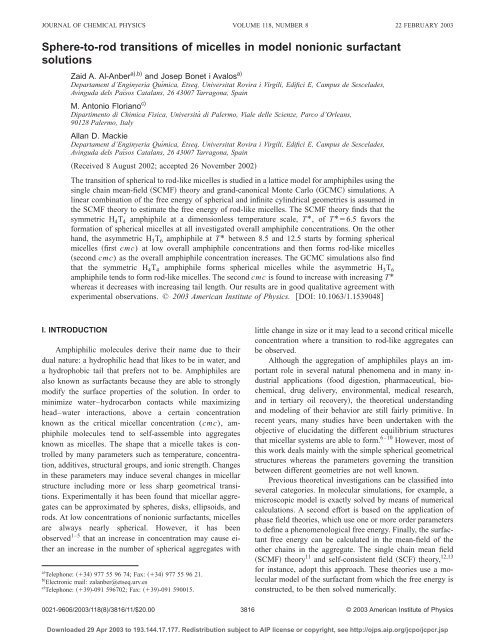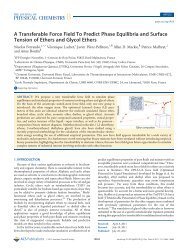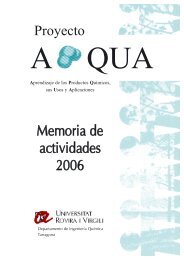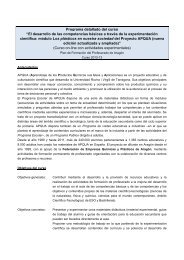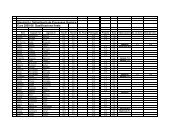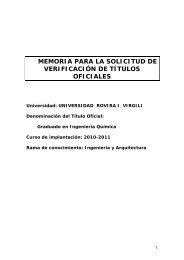Sphere-to-rod transitions of micelles in model nonionic surfactant ...
Sphere-to-rod transitions of micelles in model nonionic surfactant ...
Sphere-to-rod transitions of micelles in model nonionic surfactant ...
Create successful ePaper yourself
Turn your PDF publications into a flip-book with our unique Google optimized e-Paper software.
JOURNAL OF CHEMICAL PHYSICS VOLUME 118, NUMBER 8 22 FEBRUARY 2003<br />
<strong>Sphere</strong>-<strong>to</strong>-<strong>rod</strong> <strong>transitions</strong> <strong>of</strong> <strong>micelles</strong> <strong>in</strong> <strong>model</strong> <strong>nonionic</strong> <strong>surfactant</strong><br />
solutions<br />
Zaid A. Al-Anber a),b) and Josep Bonet i Avalos a)<br />
Departament d’Eng<strong>in</strong>yeria Química, Etseq, Universitat Rovira i Virgili, Edifici E, Campus de Sescelades,<br />
Av<strong>in</strong>guda dels Països Catalans, 26 43007 Tarragona, Spa<strong>in</strong><br />
M. An<strong>to</strong>nio Floriano c)<br />
Dipartimen<strong>to</strong> di Chimica Fisica, Università di Palermo, Viale delle Scienze, Parco d’Orleans,<br />
90128 Palermo, Italy<br />
Allan D. Mackie<br />
Departament d’Eng<strong>in</strong>yeria Química, Etseq, Universitat Rovira i Virgili, Edifici E, Campus de Sescelades,<br />
Av<strong>in</strong>guda dels Països Catalans, 26 43007 Tarragona, Spa<strong>in</strong><br />
Received 8 August 2002; accepted 26 November 2002<br />
The transition <strong>of</strong> spherical <strong>to</strong> <strong>rod</strong>-like <strong>micelles</strong> is studied <strong>in</strong> a lattice <strong>model</strong> for amphiphiles us<strong>in</strong>g the<br />
s<strong>in</strong>gle cha<strong>in</strong> mean-field SCMF theory and grand-canonical Monte Carlo GCMC simulations. A<br />
l<strong>in</strong>ear comb<strong>in</strong>ation <strong>of</strong> the free energy <strong>of</strong> spherical and <strong>in</strong>f<strong>in</strong>ite cyl<strong>in</strong>drical geometries is assumed <strong>in</strong><br />
the SCMF theory <strong>to</strong> estimate the free energy <strong>of</strong> <strong>rod</strong>-like <strong>micelles</strong>. The SCMF theory f<strong>in</strong>ds that the<br />
symmetric H4T4 amphiphile at a dimensionless temperature scale, T*, <strong>of</strong> T*6.5 favors the<br />
formation <strong>of</strong> spherical <strong>micelles</strong> at all <strong>in</strong>vestigated overall amphiphile concentrations. On the other<br />
hand, the asymmetric H3T6 amphiphile at T* between 8.5 and 12.5 starts by form<strong>in</strong>g spherical<br />
<strong>micelles</strong> first cmc) at low overall amphiphile concentrations and then forms <strong>rod</strong>-like <strong>micelles</strong><br />
second cmc) as the overall amphiphile concentration <strong>in</strong>creases. The GCMC simulations also f<strong>in</strong>d<br />
that the symmetric H4T4 amphiphile forms spherical <strong>micelles</strong> while the asymmetric H3T6 amphiphile tends <strong>to</strong> form <strong>rod</strong>-like <strong>micelles</strong>. The second cmc is found <strong>to</strong> <strong>in</strong>crease with <strong>in</strong>creas<strong>in</strong>g T*<br />
whereas it decreases with <strong>in</strong>creas<strong>in</strong>g tail length. Our results are <strong>in</strong> good qualitative agreement with<br />
experimental observations. © 2003 American Institute <strong>of</strong> Physics. DOI: 10.1063/1.1539048<br />
I. INTRODUCTION<br />
Amphiphilic molecules derive their name due <strong>to</strong> their<br />
dual nature: a hydrophilic head that likes <strong>to</strong> be <strong>in</strong> water, and<br />
a hydrophobic tail that prefers not <strong>to</strong> be. Amphiphiles are<br />
also known as <strong>surfactant</strong>s because they are able <strong>to</strong> strongly<br />
modify the surface properties <strong>of</strong> the solution. In order <strong>to</strong><br />
m<strong>in</strong>imize water–hydrocarbon contacts while maximiz<strong>in</strong>g<br />
head–water <strong>in</strong>teractions, above a certa<strong>in</strong> concentration<br />
known as the critical micellar concentration (cmc), amphiphile<br />
molecules tend <strong>to</strong> self-assemble <strong>in</strong><strong>to</strong> aggregates<br />
known as <strong>micelles</strong>. The shape that a micelle takes is controlled<br />
by many parameters such as temperature, concentration,<br />
additives, structural groups, and ionic strength. Changes<br />
<strong>in</strong> these parameters may <strong>in</strong>duce several changes <strong>in</strong> micellar<br />
structure <strong>in</strong>clud<strong>in</strong>g more or less sharp geometrical <strong>transitions</strong>.<br />
Experimentally it has been found that micellar aggregates<br />
can be approximated by spheres, disks, ellipsoids, and<br />
<strong>rod</strong>s. At low concentrations <strong>of</strong> <strong>nonionic</strong> <strong>surfactant</strong>s, <strong>micelles</strong><br />
are always nearly spherical. However, it has been<br />
observed 1–5 that an <strong>in</strong>crease <strong>in</strong> concentration may cause either<br />
an <strong>in</strong>crease <strong>in</strong> the number <strong>of</strong> spherical aggregates with<br />
a Telephone: 34 977559674;Fax:34 977 55 96 21.<br />
b Electronic mail: zalanber@etseq.urv.es<br />
c Telephone: 39-091 596702; Fax: 39-091 590015.<br />
little change <strong>in</strong> size or it may lead <strong>to</strong> a second critical micelle<br />
concentration where a transition <strong>to</strong> <strong>rod</strong>-like aggregates can<br />
be observed.<br />
Although the aggregation <strong>of</strong> amphiphiles plays an important<br />
role <strong>in</strong> several natural phenomena and <strong>in</strong> many <strong>in</strong>dustrial<br />
applications food digestion, pharmaceutical, biochemical,<br />
drug delivery, environmental, medical research,<br />
and <strong>in</strong> tertiary oil recovery, the theoretical understand<strong>in</strong>g<br />
and <strong>model</strong><strong>in</strong>g <strong>of</strong> their behavior are still fairly primitive. In<br />
recent years, many studies have been undertaken with the<br />
objective <strong>of</strong> elucidat<strong>in</strong>g the different equilibrium structures<br />
that micellar systems are able <strong>to</strong> form. 6–10 However, most <strong>of</strong><br />
this work deals ma<strong>in</strong>ly with the simple spherical geometrical<br />
structures whereas the parameters govern<strong>in</strong>g the transition<br />
between different geometries are not well known.<br />
Previous theoretical <strong>in</strong>vestigations can be classified <strong>in</strong><strong>to</strong><br />
several categories. In molecular simulations, for example, a<br />
microscopic <strong>model</strong> is exactly solved by means <strong>of</strong> numerical<br />
calculations. A second effort is based on the application <strong>of</strong><br />
phase field theories, which use one or more order parameters<br />
<strong>to</strong> def<strong>in</strong>e a phenomenological free energy. F<strong>in</strong>ally, the <strong>surfactant</strong><br />
free energy can be calculated <strong>in</strong> the mean-field <strong>of</strong> the<br />
other cha<strong>in</strong>s <strong>in</strong> the aggregate. The s<strong>in</strong>gle cha<strong>in</strong> mean field<br />
SCMF theory 11 and self-consistent field SCF theory, 12,13<br />
for <strong>in</strong>stance, adopt this approach. These theories use a molecular<br />
<strong>model</strong> <strong>of</strong> the <strong>surfactant</strong> from which the free energy is<br />
constructed, <strong>to</strong> be then solved numerically.<br />
0021-9606/2003/118(8)/3816/11/$20.00 3816<br />
© 2003 American Institute <strong>of</strong> Physics<br />
Downloaded 29 Apr 2003 <strong>to</strong> 193.144.17.177. Redistribution subject <strong>to</strong> AIP license or copyright, see http://ojps.aip.org/jcpo/jcpcr.jsp
J. Chem. Phys., Vol. 118, No. 8, 22 February 2003 <strong>Sphere</strong>-<strong>to</strong>-<strong>rod</strong> <strong>transitions</strong> <strong>of</strong> <strong>micelles</strong><br />
It is convenient <strong>to</strong> classify the molecular simulation<br />
studies <strong>in</strong><strong>to</strong> two categories: molecular dynamics<br />
MD, 10,14–22<br />
and Monte Carlo MC simulation<br />
methods. 11,23,34 In MD simulations, the equations <strong>of</strong> motion<br />
are solved numerically for each amphiphile. The advantage<br />
<strong>of</strong> this method is that time dependent phenomenon become<br />
accessible, however, only relatively short times can be simulated<br />
because <strong>of</strong> the fairly demand<strong>in</strong>g and calculation <strong>in</strong>tensive<br />
nature <strong>of</strong> these studies. Thus, if the time scale <strong>of</strong> <strong>in</strong>terest<br />
is longer than that practically accessible, the simulation is<br />
unable <strong>to</strong> capture the phenomenon <strong>of</strong> <strong>in</strong>terest. Rec<strong>to</strong>r et al., 10<br />
<strong>in</strong> their MD simulations, adopted a simple two-particle <strong>surfactant</strong><br />
<strong>model</strong>. In their treatment, they use the Widom 14 testparticle<br />
method <strong>to</strong> determ<strong>in</strong>e the cmc for a <strong>surfactant</strong> <strong>model</strong><br />
consist<strong>in</strong>g <strong>of</strong> one hydrophilic and another hydrophobic particle<br />
jo<strong>in</strong>ed by nonharmonic spr<strong>in</strong>gs. Karaborni et al. 15 studied<br />
the effect <strong>of</strong> cha<strong>in</strong> length and head group properties on<br />
the <strong>in</strong>ternal micelle structure, micellar shape, and cha<strong>in</strong> conformation<br />
<strong>in</strong>side the micelle. They found that the average<br />
aggregate shape is somewhat nonspherical, regardless <strong>of</strong><br />
head group size and <strong>surfactant</strong> cha<strong>in</strong> length. The molecular<br />
dynamics simulations <strong>of</strong> Palmer and Liu 16 <strong>in</strong>corporated an<br />
additional bend<strong>in</strong>g energy term us<strong>in</strong>g a quasi-realistic <strong>model</strong>.<br />
Hat<strong>to</strong>n et al., 17 Smit et al., 18–20 and recently Fodi et al. 21<br />
used coarse-gra<strong>in</strong>ed <strong>model</strong>s <strong>to</strong> study the self assembly <strong>of</strong> a<br />
<strong>nonionic</strong> <strong>surfactant</strong> systems. These <strong>model</strong>s give access <strong>to</strong><br />
much longer time scales than those accessible with realistic<br />
potentials and, as a consequence, the <strong>surfactant</strong>s can selfassemble<br />
<strong>in</strong><strong>to</strong> their preferred structures. With realistic potentials,<br />
it is usually necessary <strong>to</strong> pre-assemble the micelle prior<br />
<strong>to</strong> the simulation.<br />
Monte Carlo simulations <strong>of</strong> amphiphilic solutions <strong>in</strong> lattices<br />
have been used extensively <strong>in</strong> the last 20 years.<br />
Larson 23–25 has studied the structure <strong>of</strong> aggregates for different<br />
types <strong>of</strong> amphiphiles <strong>in</strong> solution. Mattice et al. 26–28 calculated<br />
segment distribution pr<strong>of</strong>iles <strong>of</strong> the <strong>micelles</strong> and the<br />
dependence <strong>of</strong> the cmc on the <strong>surfactant</strong> composition. Desplat<br />
and Care 29 performed lattice Monte Carlo simulation<br />
where the <strong>surfactant</strong>s consisted <strong>of</strong> s particles with one <strong>of</strong><br />
them serv<strong>in</strong>g as a head and the rema<strong>in</strong><strong>in</strong>g s-1 form<strong>in</strong>g the<br />
tail <strong>of</strong> the <strong>surfactant</strong>. Their calculation captured the micellar<br />
size distribution as a function <strong>of</strong> temperature. Equilibrium<br />
properties <strong>of</strong> <strong>nonionic</strong> <strong>micelles</strong> were also studied by L<strong>in</strong>se<br />
et al. 30 and Mackie et al. 11 us<strong>in</strong>g lattice Monte Carlo simulations.<br />
Equilibrium size and shape distributions <strong>of</strong> selfassembled<br />
<strong>micelles</strong> were <strong>in</strong>vestigated by Hat<strong>to</strong>n et al. 31 They<br />
found that the equilibration <strong>of</strong> simulated micellar systems is<br />
better moni<strong>to</strong>red us<strong>in</strong>g the average aggregate size rather than<br />
the configuration energy <strong>of</strong> the system. Rajagopalan et al. 32<br />
simulated the effects <strong>of</strong> the amphiphile tail length on the first<br />
cmc. Their simulations are consistent with experimental results<br />
for several non-ionic <strong>surfactant</strong>s <strong>in</strong> water. The thermal<br />
behavior <strong>of</strong> aggregates <strong>of</strong> amphiphilic molecules <strong>in</strong> water for<br />
a three-dimensional lattice <strong>model</strong> was studied by Figueiredo<br />
and Giradi. 33 Their <strong>model</strong> consists <strong>of</strong> amphiphilic molecules<br />
with a s<strong>in</strong>gle polar head and a hydrophobic tail formed <strong>of</strong><br />
monomers <strong>in</strong> a solution <strong>of</strong> water where the water molecules<br />
are <strong>model</strong>ed as occupy<strong>in</strong>g one lattice site. Floriano et al. 34<br />
studied the formation <strong>of</strong> <strong>micelles</strong> by a novel methodology<br />
3817<br />
based on grand-canonical Monte Carlo GCMC simulations.<br />
Their methodology is based on the comb<strong>in</strong>ation <strong>of</strong> freeenergy<br />
<strong>in</strong>formation from a series <strong>of</strong> simulations <strong>in</strong> small systems<br />
by his<strong>to</strong>gram reweight<strong>in</strong>g.<br />
Methods based on phase field theories 1,35,36 do not rely<br />
as much, if at all, on the computer capacity as <strong>in</strong> the case <strong>of</strong><br />
MD and MC techniques. These theories have been applied <strong>to</strong><br />
the study <strong>of</strong> micellization and phase behavior for <strong>nonionic</strong><br />
<strong>surfactant</strong> solutions. A major drawback with these treatments<br />
is that they conta<strong>in</strong> parameters that cannot be directly related<br />
<strong>to</strong> a microscopic <strong>model</strong>. F<strong>in</strong>ally, a mean-field approximation<br />
based on the use <strong>of</strong> ideal Gaussian cha<strong>in</strong>s can be used. For<br />
<strong>in</strong>stance, the SCF theory was orig<strong>in</strong>ally developed by<br />
Scheutjens and Fleer 37,38 <strong>to</strong> treat polymer adsorption. Later it<br />
has been generalized by Leermakers 12,13 <strong>to</strong> treat <strong>surfactant</strong><br />
aggregates. Bohmer et al. 39,40 showed that this theory closely<br />
follows many experimental observations. L<strong>in</strong>se 41 demonstrated<br />
how the SCF theory can be used <strong>to</strong> <strong>model</strong> solutions <strong>of</strong><br />
polyethylene oxide-polypropylene oxide copolymers and<br />
lastly Wijmans and L<strong>in</strong>se 30 used the SCF <strong>to</strong> study the aggregation<br />
<strong>of</strong> short <strong>nonionic</strong> l<strong>in</strong>ear <strong>surfactant</strong> cha<strong>in</strong>s <strong>in</strong> spherical<br />
<strong>micelles</strong> and compared their f<strong>in</strong>d<strong>in</strong>gs with their MC simulations<br />
on the same system. These results showed that the SCF<br />
theory fails <strong>in</strong> predict<strong>in</strong>g the right micellar size distribution<br />
and cmc, giv<strong>in</strong>g larger aggregation numbers and a cmc<br />
much lower by several orders <strong>of</strong> magnitude than the results<br />
obta<strong>in</strong>ed by simulation. A slightly different approach is <strong>of</strong>fered<br />
by the SCMF theory, orig<strong>in</strong>ally developed by Szleifer<br />
for dry core <strong>micelles</strong> 42,43 and generalized for polymer solvent<br />
systems. 44 Mackie et al. 11 applied the SCMF theory <strong>to</strong> treat<br />
micellar systems without the assumption <strong>of</strong> a sharp <strong>in</strong>terface<br />
and a dry core for lattice amphiphiles. The predictions <strong>of</strong> the<br />
theory were compared with MC simulations and excellent<br />
quantitative agreement was found for the first cmc. Furthermore,<br />
the predictions for the molecular organization <strong>in</strong> the<br />
aggregates were <strong>in</strong> very good agreement with the simulation<br />
results. However, the micelle aggregation numbers were<br />
under-predicted. Recently Szleifer et al. 45 applied the SCMF<br />
theory <strong>to</strong> a cont<strong>in</strong>uous space <strong>model</strong>. They found that the<br />
micellar size distribution was <strong>in</strong> very good agreement with<br />
MD calculations. In general, the ma<strong>in</strong> advantage <strong>of</strong> meanfield<br />
calculations is the ability <strong>to</strong> estimate the micelle properties<br />
with relatively little computational effort as compared<br />
<strong>to</strong> molecular simulations. In contrast, the simulations are<br />
useful for provid<strong>in</strong>g detailed quantitative <strong>in</strong>formation <strong>in</strong> numerical<br />
form but do not give the overall qualitative view. In<br />
general, mean-field theories, which are easier <strong>to</strong> solve, provide<br />
a good <strong>in</strong>itial overview <strong>of</strong> the system with simulation<br />
provid<strong>in</strong>g more detailed <strong>in</strong>formation where required. In summary,<br />
the comb<strong>in</strong>ation <strong>of</strong> simulation and mean-field theory<br />
can contribute, <strong>in</strong> a complementary fashion, <strong>to</strong> a better understand<strong>in</strong>g<br />
<strong>of</strong> the behavior <strong>of</strong> the system.<br />
In the present work we are ma<strong>in</strong>ly concerned with micellar<br />
shape. As mentioned before, many experimental studies<br />
have reported that a transition <strong>of</strong> spherical <strong>micelles</strong> <strong>in</strong><strong>to</strong><br />
elongated ones may occur above a certa<strong>in</strong> value <strong>of</strong> the bulk<br />
<strong>surfactant</strong> concentration, referred <strong>to</strong> as the second cmc. 46–48<br />
Recently, Bernheim-Groswasser et al. concluded that micellar<br />
populations <strong>of</strong> both the dimeric gem<strong>in</strong>i 49 and <strong>nonionic</strong><br />
Downloaded 29 Apr 2003 <strong>to</strong> 193.144.17.177. Redistribution subject <strong>to</strong> AIP license or copyright, see http://ojps.aip.org/jcpo/jcpcr.jsp
3818 J. Chem. Phys., Vol. 118, No. 8, 22 February 2003 Al-Anber et al.<br />
<strong>surfactant</strong> C 12E 5 50 are characterized by two dist<strong>in</strong>ct stages<br />
and two dist<strong>in</strong>ct micellar sizes when the amphiphile concentration<br />
and temperature <strong>in</strong>crease. Also, their studies show<br />
that the diameter <strong>of</strong> the endcaps <strong>of</strong> the elongated <strong>micelles</strong> is<br />
larger than that <strong>of</strong> the cyl<strong>in</strong>drical body. Nonionic <strong>surfactant</strong>s<br />
C 12E 5 was also studied experimentally at 3 °C by Ot<strong>to</strong> Glatter<br />
et al. 51 They found that two peaks are formed <strong>in</strong> the cluster<br />
distribution <strong>in</strong>dicat<strong>in</strong>g that cyl<strong>in</strong>drical structures are<br />
formed.<br />
The growth <strong>of</strong> spherical <strong>micelles</strong> <strong>in</strong><strong>to</strong> elongated ones has<br />
been <strong>in</strong>vestigated us<strong>in</strong>g simple pack<strong>in</strong>g arguments by assum<strong>in</strong>g<br />
a spherocyl<strong>in</strong>drical geometry. 1 These arguments assume<br />
that the spherocyl<strong>in</strong>drical <strong>micelles</strong> consist <strong>of</strong> cyl<strong>in</strong>ders term<strong>in</strong>ated<br />
by hemispherical endcaps <strong>of</strong> the same diameter as the<br />
cyl<strong>in</strong>der. It is also assumed that the <strong>surfactant</strong>s have a standard<br />
chemical potential that is lower <strong>in</strong> the cyl<strong>in</strong>drical body<br />
than <strong>in</strong> the endcaps. These two assumptions are sufficient <strong>to</strong><br />
expla<strong>in</strong> the micellar growth. Porte et al. 48 accounted for the<br />
existence <strong>of</strong> a second cmc us<strong>in</strong>g a phenomenological structure<br />
<strong>model</strong> <strong>of</strong> l<strong>in</strong>ear <strong>micelles</strong>. Recently, Ben-Shaul et al. 52<br />
have also used a molecular-level theory <strong>to</strong> study amphiphile<br />
pack<strong>in</strong>g <strong>in</strong> l<strong>in</strong>ear <strong>micelles</strong>. They found that the early stages<br />
<strong>of</strong> growth <strong>in</strong>volve an energetic barrier, result<strong>in</strong>g <strong>in</strong> a gap <strong>in</strong><br />
the micellar size distribution. Small <strong>micelles</strong> appeared <strong>in</strong> solution<br />
when they studied at low amphiphile concentration.<br />
They demonstrated the concept <strong>of</strong> the second critical micelle<br />
concentration, which represents <strong>in</strong> this case a transition from<br />
spherical <strong>to</strong> cyl<strong>in</strong>drical <strong>micelles</strong>, by way <strong>of</strong> calculations <strong>of</strong><br />
micellar size distributions and average aggregation numbers<br />
as a function <strong>of</strong> the <strong>to</strong>tal amphiphile concentration.<br />
The ma<strong>in</strong> objective <strong>of</strong> this work is <strong>to</strong> apply SCMF<br />
theory and the GCMC simulation method <strong>to</strong> study dilute<br />
micellar solutions <strong>of</strong> s<strong>in</strong>gle tail <strong>nonionic</strong> <strong>surfactant</strong>s and, <strong>in</strong><br />
particular, <strong>to</strong> <strong>in</strong>vestigate the transition between spherical and<br />
cyl<strong>in</strong>drical <strong>micelles</strong> and hence <strong>to</strong> calculate the second critical<br />
micelle concentrations. Another objective is <strong>to</strong> study the effect<br />
<strong>of</strong> tail length <strong>of</strong> amphiphile molecules and the temperature<br />
on the second critical micelle concentration, cmc.<br />
The rest <strong>of</strong> this work is organized as follows: the theoretical<br />
<strong>model</strong><strong>in</strong>g and methodology are presented <strong>in</strong> Secs. II<br />
and III, respectively, Sec. IV conta<strong>in</strong>s our results and discussion,<br />
and f<strong>in</strong>ally the ma<strong>in</strong> conclusions <strong>of</strong> this work are given<br />
<strong>in</strong> Sec. V.<br />
II. THEORETICAL MODELING<br />
A. Lattice <strong>model</strong><br />
In the <strong>model</strong> studied here, orig<strong>in</strong>ally proposed by<br />
Larson, 23 space is divided up <strong>in</strong><strong>to</strong> a cubic lattice <strong>of</strong> sites <strong>in</strong><br />
three dimensions with a coord<strong>in</strong>ation number, z the number<br />
<strong>of</strong> nearest neighbor sites, equal <strong>to</strong> 26. We <strong>model</strong> the amphiphile<br />
molecules as l<strong>in</strong>ear cha<strong>in</strong>s <strong>of</strong> freely jo<strong>in</strong>ted segments<br />
beads each occupy<strong>in</strong>g one lattice site whereas the<br />
solvent occupies s<strong>in</strong>gle sites. We refer <strong>to</strong> the amphiphile<br />
molecules as HxTy where x and y represent the number <strong>of</strong><br />
segments <strong>in</strong> the head-group H and tail T, respectively. A<br />
water-like solvent particle is denoted by H and an oil-like<br />
particle by T.<br />
This <strong>model</strong> is suitable for describ<strong>in</strong>g the behavior <strong>of</strong><br />
<strong>nonionic</strong> <strong>surfactant</strong>s such as polyoxyethylene referred <strong>to</strong> as<br />
C mEO n , where the oxyethylene units —C–C–O— make<br />
up the head part and the alkyl cha<strong>in</strong> forms the tail. Given that<br />
a head group H <strong>in</strong> our <strong>model</strong> is approximately equivalent <strong>to</strong><br />
one oxyethylene unit and one tail T represents about 3 CH 2<br />
groups, 21 then the H 4T 4 and H 3T 6 <strong>surfactant</strong>s studied <strong>in</strong> this<br />
work are roughly equivalent <strong>to</strong> the real <strong>surfactant</strong>s <strong>of</strong> C 12EO 4<br />
and C 18EO 3 , respectively.<br />
All systems studied are b<strong>in</strong>ary mixtures <strong>of</strong> amphiphile<br />
and solvent. The lattice is fully occupied. If an H-type site<br />
belong<strong>in</strong>g <strong>to</strong> a water monomer or the head <strong>of</strong> a <strong>surfactant</strong><br />
<strong>in</strong>teracts with another H-type site the result<strong>in</strong>g energy is<br />
HH . An <strong>in</strong>teraction occurs when two sites are <strong>in</strong> contact.<br />
The T–T and H–T <strong>in</strong>teraction energies are denoted by TT ,<br />
and HT , respectively. There is only one relevant energy parameter<br />
due <strong>to</strong> the lattice conservation equations: HT<br />
1<br />
2 HH 1<br />
2 TT . The TT <strong>in</strong>teraction was set <strong>to</strong> 2 result<strong>in</strong>g<br />
<strong>in</strong> attractive <strong>in</strong>teractions for nearest-neighbor tail–tail contacts<br />
and the HH and HT were set <strong>to</strong> zero. A dimensionless<br />
temperature scale, T*, was def<strong>in</strong>ed as T*k BT/ where k B<br />
is Boltzmann’s constant and T is the temperature. It should<br />
be stressed that a different choice <strong>of</strong> energy parameters<br />
would have no real physical significance with regards <strong>to</strong> the<br />
behavior <strong>of</strong> the <strong>model</strong> and would merely modify the dimensionless<br />
temperature scale.<br />
B. Mass action <strong>model</strong><br />
Let us consider the equilibrium condition for a micellar<br />
system. This is given by the requirement that the chemical<br />
potential <strong>of</strong> the amphiphile should be the same <strong>in</strong> all environments,<br />
i.e., as an isolated amphiphile <strong>in</strong> solution, <strong>in</strong> small<br />
globular <strong>micelles</strong>, or <strong>in</strong> any type <strong>of</strong> aggregate <strong>of</strong> arbitrary<br />
geometry and size. For an ideal solution,<br />
N N 0 k BT<br />
N ln X N<br />
N const 1 , 1<br />
where X N is the concentration <strong>of</strong> aggregates conta<strong>in</strong><strong>in</strong>g N<br />
amphiphiles <strong>in</strong> the solution, N and 1 are the chemical<br />
potentials <strong>of</strong> an aggregate <strong>of</strong> size N and an isolated amphiphile<br />
<strong>in</strong> solution, respectively; N 0 is the standard chemical<br />
potential per amphiphile molecule <strong>in</strong> an aggregate <strong>of</strong> size<br />
N. The preferred pack<strong>in</strong>g geometry <strong>of</strong> the micelle is that<br />
correspond<strong>in</strong>g <strong>to</strong> N 0 m<strong>in</strong> 1 for an aggregate <strong>of</strong> fixed size N.<br />
Rewrit<strong>in</strong>g the above equation <strong>to</strong> obta<strong>in</strong> the cluster distribution<br />
<strong>in</strong> terms <strong>of</strong> the mole fraction <strong>of</strong> the molecules <strong>in</strong> aggregates<br />
<strong>of</strong> size N gives<br />
N<br />
kBT X NN X 1 exp 1 0 N 0<br />
, 2<br />
where 1 0 is the standard chemical potential <strong>of</strong> an isolated<br />
amphiphile. The cluster size distribution is determ<strong>in</strong>ed by the<br />
difference <strong>in</strong> the standard chemical potentials between an<br />
isolated amphiphile and an amphiphile <strong>in</strong> the aggregate<br />
( 1 0 N 0 ). The SCMF theory described below is designed <strong>to</strong><br />
determ<strong>in</strong>e this difference <strong>of</strong> standard chemical potential for<br />
<strong>micelles</strong> <strong>of</strong> arbitrary size N and a specified geometry.<br />
Downloaded 29 Apr 2003 <strong>to</strong> 193.144.17.177. Redistribution subject <strong>to</strong> AIP license or copyright, see http://ojps.aip.org/jcpo/jcpcr.jsp
J. Chem. Phys., Vol. 118, No. 8, 22 February 2003 <strong>Sphere</strong>-<strong>to</strong>-<strong>rod</strong> <strong>transitions</strong> <strong>of</strong> <strong>micelles</strong><br />
C. Spherocyl<strong>in</strong>drical case<br />
A simple <strong>model</strong> was used <strong>to</strong> estimate the standard<br />
chemical potential <strong>of</strong> spherocyl<strong>in</strong>ders, N 0(sphcyl) for an aggregate<br />
<strong>of</strong> size N by assum<strong>in</strong>g a l<strong>in</strong>ear comb<strong>in</strong>ation <strong>of</strong> the free<br />
energy <strong>of</strong> spherical and <strong>in</strong>f<strong>in</strong>ite cyl<strong>in</strong>drical geometries.<br />
1<br />
0(sphcyl)<br />
N <br />
N N sph * 0 0<br />
sph<br />
*NNsph * cyl *, 3<br />
where NN sph * N cyl is the <strong>to</strong>tal number <strong>of</strong> amphiphiles <strong>in</strong><br />
the spherocyl<strong>in</strong>der, Ncyl is the number <strong>of</strong> amphiphiles <strong>in</strong> the<br />
cyl<strong>in</strong>drical section, Nsph * is the number <strong>of</strong> amphiphiles <strong>in</strong> the<br />
0<br />
spherical section. The standard chemical potential, sph * ,is<br />
chosen as the m<strong>in</strong>imum as a function <strong>of</strong> number <strong>of</strong> cha<strong>in</strong>s <strong>in</strong><br />
0<br />
the aggregate and cyl * is the m<strong>in</strong>imum value <strong>of</strong> standard<br />
chemical potential <strong>in</strong> the <strong>in</strong>f<strong>in</strong>ite cyl<strong>in</strong>drical geometry. The<br />
micellar size distribution <strong>of</strong> spherocyl<strong>in</strong>drical <strong>micelles</strong> is calculated<br />
by <strong>in</strong>t<strong>rod</strong>uc<strong>in</strong>g Eq. 3 <strong>in</strong><strong>to</strong> the mass action <strong>model</strong>,<br />
Eq. 2.<br />
It should be noted that we use here a comb<strong>in</strong>ation <strong>of</strong><br />
cyl<strong>in</strong>drical and spherical sections correspond<strong>in</strong>g <strong>to</strong> the respective<br />
m<strong>in</strong>imum free energy for each case even though the<br />
diameters <strong>of</strong> the two sections may be different.<br />
D. SCMF theory<br />
The basic idea <strong>of</strong> SCMF theory is <strong>to</strong> consider a central<br />
cha<strong>in</strong> with all <strong>of</strong> its <strong>in</strong>tramolecular <strong>in</strong>teractions exactly taken<br />
<strong>in</strong><strong>to</strong> account while the <strong>in</strong>termolecular <strong>in</strong>teractions are considered<br />
with<strong>in</strong> a mean-field approximation. S<strong>in</strong>ce a micellar aggregate<br />
is clearly <strong>in</strong>homogeneous, the <strong>in</strong>termolecular meanfield<br />
<strong>in</strong>teraction is also <strong>in</strong>homogeneous. The theory is<br />
derived by determ<strong>in</strong><strong>in</strong>g the probability distribution function,<br />
(pdf ), which is the probability that for a given geometry the<br />
amphiphile will be found <strong>in</strong> a particular conformation. From<br />
this distribution any property <strong>of</strong> the cha<strong>in</strong> can be computed<br />
as an ensemble average. To use this theory, it is necessary <strong>to</strong><br />
specify the geometry <strong>of</strong> <strong>in</strong>terest. In order <strong>to</strong> f<strong>in</strong>d the pdf, a<br />
mean-field approximation is <strong>in</strong>voked and the simpler problem<br />
<strong>of</strong> any arbitrary cha<strong>in</strong> under the average <strong>in</strong>teraction with<br />
its neighbors is solved. Specifically, the pdf that m<strong>in</strong>imizes<br />
the free energy per cha<strong>in</strong> is sought subject <strong>to</strong> the lattice<br />
s<strong>in</strong>gle occupancy constra<strong>in</strong>ts correspond<strong>in</strong>g <strong>to</strong> the given aggregation<br />
geometry.<br />
In this work we consider the aggregate <strong>in</strong> concentric<br />
layers. For a dilute solution <strong>of</strong> <strong>micelles</strong> we can write the<br />
Helmholtz free energy, F, <strong>of</strong> a micelle fixed <strong>in</strong> space with N<br />
amphiphiles as<br />
FNE S<br />
kB r<br />
n sr s , 4<br />
where E is the <strong>to</strong>tal energy <strong>of</strong> the amphiphiles <strong>in</strong> the micelle,<br />
S is the entropy <strong>of</strong> the micelle, 1/k BT, n s is the number<br />
<strong>of</strong> solvent molecules, T is the temperature, and s is the<br />
standard chemical potential <strong>of</strong> the solvent. The probability<br />
distribution function, P(), is found by m<strong>in</strong>imiz<strong>in</strong>g the free<br />
energy 4 subject <strong>to</strong> the pack<strong>in</strong>g constra<strong>in</strong>t equation<br />
s(r)(r)1 by <strong>in</strong>t<strong>rod</strong>uc<strong>in</strong>g a set <strong>of</strong> Lagrange multipliers,<br />
(r), <strong>to</strong> give<br />
P q*<br />
q* ,<br />
q*exp r<br />
<br />
TT<br />
<br />
2 r 5<br />
<strong>in</strong>t<br />
rn Hr,n Tr, TTnTT N<br />
Vr n n,Tr,n T r<br />
n n,Trn Tr, ,<br />
3819<br />
where denotes an ensemble average, is the set <strong>of</strong> nonoverlapp<strong>in</strong>g<br />
<strong>in</strong>dependent cha<strong>in</strong> configurations, r is the radial<br />
distance from the center <strong>of</strong> the spherical and <strong>in</strong>f<strong>in</strong>ite cyl<strong>in</strong>drical<br />
<strong>micelles</strong>, s(r) is the volume fraction <strong>of</strong> solvent and,<br />
(r) is the cha<strong>in</strong> volume fraction, V(r) is the <strong>to</strong>tal volume<br />
<strong>of</strong> the system <strong>in</strong> layer r, nH(T) is the number <strong>of</strong> head tail<br />
groups, nn,T(r) is the number <strong>of</strong> nonoccupied nearest-<br />
<strong>in</strong>t<br />
neighbor contacts <strong>in</strong> shell r per cha<strong>in</strong>, nTT is the number <strong>of</strong><br />
<strong>in</strong>tramolecular tail–tail contacts per cha<strong>in</strong>, and TT TT is<br />
the dimensionless <strong>in</strong>teraction parameter. The solvent density<br />
pr<strong>of</strong>ile, s(r), is given by<br />
srexp„rs…, 6<br />
where the thermodynamic equilibrium condition that the<br />
chemical potential <strong>of</strong> the solvent, s , must be constant at all<br />
r has been <strong>in</strong>t<strong>rod</strong>uced. (r) is the osmotic pressure necessary<br />
<strong>to</strong> keep the s constant at all r. The cmc and micellar<br />
size distribution is obta<strong>in</strong>ed by Eq. 1 which requires the<br />
standard chemical potential <strong>of</strong> formation,<br />
F<br />
0<br />
N ln qn, 7<br />
N<br />
where n is the number <strong>of</strong> sites occupied by an amphiphile<br />
and is constant. The derivation <strong>of</strong> Eqs. 6 and 7 has previously<br />
been presented. 11<br />
III. METHODOLOGY<br />
A. SCMF theory<br />
To solve the pack<strong>in</strong>g constra<strong>in</strong>t equations, space was discretized<br />
<strong>in</strong><strong>to</strong> f<strong>in</strong>ite concentric layers and the number <strong>of</strong> segments<br />
per layer <strong>of</strong> each generated cha<strong>in</strong> was counted. To f<strong>in</strong>d<br />
the lateral pressure, (r), we substituted the form <strong>of</strong> the pdf<br />
Eq. 5 and that <strong>of</strong> the solvent density pr<strong>of</strong>ile, s(r), Eq.<br />
6 <strong>in</strong><strong>to</strong> the pack<strong>in</strong>g constra<strong>in</strong>t equations. The result is a set<br />
<strong>of</strong> nonl<strong>in</strong>ear self-consistent equations that can be solved by<br />
standard numerical methods. The necessary <strong>in</strong>put data that is<br />
needed <strong>to</strong> solve the equations the set <strong>of</strong> nonl<strong>in</strong>ear selfconsistent<br />
equations are the cha<strong>in</strong> conformations, the number<br />
<strong>of</strong> cha<strong>in</strong>s <strong>in</strong> the aggregate, shell volumes, and the temperature.<br />
The outputs are the set <strong>of</strong> lateral pressures, (r).<br />
With these quantities and the pdf Eq. 5, any desired average<br />
conformational and thermodynamic property <strong>of</strong> the micellar<br />
aggregate can be obta<strong>in</strong>ed.<br />
The cha<strong>in</strong> conformations were generated us<strong>in</strong>g the<br />
Rosenbluth and Rosenbluth cha<strong>in</strong> growth algorithm. 53 In-<br />
<strong>in</strong>t<br />
tramolecular tail–tail <strong>in</strong>teractions, nTT(), were calculated<br />
Downloaded 29 Apr 2003 <strong>to</strong> 193.144.17.177. Redistribution subject <strong>to</strong> AIP license or copyright, see http://ojps.aip.org/jcpo/jcpcr.jsp
3820 J. Chem. Phys., Vol. 118, No. 8, 22 February 2003 Al-Anber et al.<br />
exactly for all the configurations. Once a set <strong>of</strong> configurations<br />
is obta<strong>in</strong>ed, they can be placed on the lattice, and the<br />
cha<strong>in</strong> distributions tail, head and nearest neighbor contacts<br />
can be counted as a function <strong>of</strong> the distance from the aggregate<br />
center.<br />
In this work, 50 000 cha<strong>in</strong> configurations were randomly<br />
generated and placed on a lattice divided <strong>in</strong><strong>to</strong> spherical and<br />
<strong>in</strong>f<strong>in</strong>ite cyl<strong>in</strong>drical shells. The first tail segments <strong>of</strong> the configurations<br />
were placed at four different radii on the diagonal<br />
and straight as well as their symmetrically <strong>in</strong>verted configurations<br />
for a <strong>to</strong>tal <strong>of</strong> 16 different positions for each configuration.<br />
This means that we use a set <strong>of</strong> 810 5 cha<strong>in</strong> conformations<br />
for each system <strong>model</strong>. The same results were<br />
obta<strong>in</strong>ed when 10 7 configurations were used.<br />
Once all <strong>of</strong> the cha<strong>in</strong> conformations were generated, the<br />
pack<strong>in</strong>g constra<strong>in</strong>t equations were solved by us<strong>in</strong>g the appropriate<br />
nonl<strong>in</strong>ear equation solv<strong>in</strong>g rout<strong>in</strong>es from the IMSL library.<br />
The standard chemical potential <strong>of</strong> a micelle conta<strong>in</strong><strong>in</strong>g<br />
N amphiphiles was calculated us<strong>in</strong>g Eq. 7 by summ<strong>in</strong>g<br />
over the set <strong>of</strong> cha<strong>in</strong> configurations and the different positions.<br />
The cluster size distribution, X N , was calculated by<br />
<strong>in</strong>t<strong>rod</strong>uc<strong>in</strong>g the values <strong>of</strong> the standard chemical potential <strong>of</strong><br />
an isolated amphiphile and N-<strong>micelles</strong> that were calculated<br />
by the SCMF theory with<strong>in</strong> the mass action <strong>model</strong>.<br />
We def<strong>in</strong>e the first critical micelle concentration as the<br />
isolated amphiphile concentration at which a l<strong>in</strong>e <strong>of</strong> unit<br />
slope pass<strong>in</strong>g through the orig<strong>in</strong> <strong>in</strong>tersects a straight l<strong>in</strong>e<br />
through the free isolated amphiphile concentration beyond<br />
the onset <strong>of</strong> micellization <strong>in</strong> a plot <strong>of</strong> free isolated amphiphile<br />
mole fraction versus <strong>to</strong>tal amphiphile mole fraction.<br />
The physical mean<strong>in</strong>g <strong>of</strong> this def<strong>in</strong>ition is that it corresponds<br />
<strong>to</strong> the mole fraction at which spherical <strong>micelles</strong> start appear<strong>in</strong>g<br />
<strong>in</strong> the system. 1<br />
To estimate the standard chemical potential <strong>of</strong> a spherocyl<strong>in</strong>der<br />
<strong>rod</strong>-like for an aggregate <strong>of</strong> size N, the m<strong>in</strong>imum<br />
value <strong>of</strong> the standard chemical potential <strong>in</strong> the spherical and<br />
<strong>in</strong>f<strong>in</strong>ite cyl<strong>in</strong>drical geometries was found. The result <strong>of</strong> substitut<strong>in</strong>g<br />
these values <strong>in</strong><strong>to</strong> Eq. 3 gives the standard chemical<br />
potential <strong>of</strong> a spherocyl<strong>in</strong>der. The cluster size distribution <strong>of</strong><br />
spherocyl<strong>in</strong>ders and hence the second critical micelle concentration<br />
were calculated by <strong>in</strong>t<strong>rod</strong>uc<strong>in</strong>g values <strong>of</strong> the standard<br />
chemical potential <strong>of</strong> isolated amphiphiles and<br />
N-spherocyl<strong>in</strong>ders <strong>micelles</strong> <strong>in</strong><strong>to</strong> the mass action <strong>model</strong>. We<br />
def<strong>in</strong>e the second critical micelle concentration as the po<strong>in</strong>t<br />
at which a straight l<strong>in</strong>e pass<strong>in</strong>g through the saturated spherical<br />
concentration <strong>in</strong>tersects a l<strong>in</strong>e pass<strong>in</strong>g through spherical<br />
concentration before it saturates <strong>in</strong> a plot <strong>of</strong> spherical <strong>micelles</strong><br />
mole fraction versus <strong>to</strong>tal amphiphile mole fraction as<br />
shown <strong>in</strong> Fig. 1.<br />
B. GCMC<br />
The GCMC method with multihis<strong>to</strong>gram reweight<strong>in</strong>g<br />
was used as <strong>in</strong> previous work. 34 This approach is based on<br />
perform<strong>in</strong>g a number <strong>of</strong> simulations for a given amphiphile<br />
architecture at selected temperatures and different values <strong>of</strong><br />
imposed chemical potentials <strong>in</strong> order <strong>to</strong> collect his<strong>to</strong>grams <strong>of</strong><br />
the probability <strong>of</strong> observation <strong>of</strong> a certa<strong>in</strong> energy and number<br />
<strong>of</strong> particles. The his<strong>to</strong>grams are then comb<strong>in</strong>ed us<strong>in</strong>g the<br />
technique <strong>of</strong> Ferrenberg and Swendsen 54 <strong>to</strong> obta<strong>in</strong> the free<br />
FIG. 1. Schematic diagram <strong>of</strong> the def<strong>in</strong>ition <strong>of</strong> the second cmc where the<br />
spherical micellar mole fraction X s is given as a function <strong>of</strong> <strong>to</strong>tal <strong>surfactant</strong><br />
mole fraction X t .<br />
energy <strong>of</strong> the system over the range <strong>of</strong> temperatures and<br />
chemical potentials covered <strong>in</strong> the simulations.<br />
Simulations were performed <strong>in</strong> cubic boxes under periodic<br />
boundary conditions. The determ<strong>in</strong>ation <strong>of</strong> cluster distributions<br />
was performed follow<strong>in</strong>g the convention used <strong>in</strong><br />
previous work. 11 Two amphiphile molecules are considered<br />
<strong>to</strong> be <strong>in</strong> the same cluster if any tail segments <strong>of</strong> the first<br />
molecule are with<strong>in</strong> the <strong>in</strong>teraction range <strong>of</strong> a tail segment <strong>of</strong><br />
the second molecule. A typical mix <strong>of</strong> attempted moves was<br />
70% particle creation/annihilation, 0.5% cluster moves, and<br />
the balance reptations. Cluster moves consist <strong>of</strong> displac<strong>in</strong>g<br />
an aggregate as a whole <strong>in</strong> a random direction. In order <strong>to</strong><br />
satisfy a detailed balance, attempted cluster moves fail if the<br />
move results <strong>in</strong> the creation <strong>of</strong> new clusters. The cluster<br />
moves are necessary <strong>to</strong> achieve significant displacements <strong>of</strong><br />
micellar aggregates but have a relatively high computational<br />
cost. Configurational-bias sampl<strong>in</strong>g methods 55 were used <strong>to</strong><br />
facilitate <strong>in</strong>sertions and removals <strong>of</strong> amphiphilic molecules.<br />
A long period (210 18 ) random number genera<strong>to</strong>r 56 was<br />
used.<br />
IV. RESULTS AND DISCUSSION<br />
In the present work, we limit our <strong>in</strong>vestigation <strong>to</strong> the<br />
l<strong>in</strong>ear symmetric <strong>model</strong> amphiphile H 4T 4 at T*6.5 and the<br />
l<strong>in</strong>ear asymmetric <strong>model</strong> amphiphile H 3T 6 at T*8.5, 9.5,<br />
10.5, 11.5, and 12.5.<br />
We have divided the results <strong>in</strong><strong>to</strong> two major sections:<br />
system H 4T 4 symmetric and H 3T 6 asymmetric. For the<br />
symmetric amphiphile, we study the effect <strong>of</strong> the <strong>to</strong>tal amphiphile<br />
concentration on the transition between spherical<br />
and spherocyl<strong>in</strong>der <strong>rod</strong>-like shapes. For the asymmetric<br />
amphiphile, we also study the effect <strong>of</strong> the <strong>to</strong>tal concentration<br />
<strong>of</strong> amphiphile on the transition between spherical and<br />
spherocyl<strong>in</strong>der shapes as well as the effect <strong>of</strong> the temperature<br />
and the amphiphile tail length on the cluster size distribution<br />
and second cmc.<br />
A. H 4T 4 system<br />
The equilibrium size and shape distributions <strong>of</strong> H 4T 4<br />
<strong>micelles</strong> have been previously studied by Monte Carlo<br />
Downloaded 29 Apr 2003 <strong>to</strong> 193.144.17.177. Redistribution subject <strong>to</strong> AIP license or copyright, see http://ojps.aip.org/jcpo/jcpcr.jsp
J. Chem. Phys., Vol. 118, No. 8, 22 February 2003 <strong>Sphere</strong>-<strong>to</strong>-<strong>rod</strong> <strong>transitions</strong> <strong>of</strong> <strong>micelles</strong><br />
FIG. 2. Standard chemical potential <strong>of</strong> H 4T 4 , N 0 /kBT, as a function <strong>of</strong><br />
aggregate size N at T*6.5. Circles, squares, and solid l<strong>in</strong>es represent<br />
spherical, <strong>in</strong>f<strong>in</strong>ite cyl<strong>in</strong>drical, and spherocyl<strong>in</strong>drical geometries, respectively.<br />
In the case <strong>of</strong> the <strong>in</strong>f<strong>in</strong>ite cyl<strong>in</strong>drical geometry, the x axis gives the<br />
number <strong>of</strong> <strong>surfactant</strong>s for a 10 lattice site section <strong>of</strong> the <strong>in</strong>f<strong>in</strong>ite cyl<strong>in</strong>der.<br />
simulations. 11,34 In addition, it has been shown that, for the<br />
same system, the SCMF results for the cmc 11 and for the<br />
cluster size distribution 45 are <strong>in</strong> close agreement with those<br />
derived by simulation. In this section we use SCMF theory <strong>to</strong><br />
study the micellar shape at T*6.5. Two micellar geometries<br />
sphere and <strong>in</strong>f<strong>in</strong>ite cyl<strong>in</strong>der were used <strong>to</strong> calculate the<br />
standard chemical potential, N 0 , as a function <strong>of</strong> the aggregate<br />
size N as reported <strong>in</strong> Fig. 2. It should be stressed here<br />
that the x axis <strong>in</strong> Fig. 2 corresponds <strong>to</strong> the <strong>to</strong>tal number <strong>of</strong><br />
amphiphiles <strong>in</strong> the aggregate for the spherical and spherocyl<strong>in</strong>dircal<br />
geometries whereas it refers <strong>to</strong> a 10 lattice site<br />
section <strong>in</strong> the case <strong>of</strong> the <strong>in</strong>f<strong>in</strong>ite cyl<strong>in</strong>der a cyl<strong>in</strong>der <strong>of</strong> <strong>in</strong>f<strong>in</strong>ite<br />
length always has an <strong>in</strong>f<strong>in</strong>ite number <strong>of</strong> amphiphiles;<br />
hence it is necessary <strong>to</strong> specify the number <strong>of</strong> amphiphiles<br />
belong<strong>in</strong>g <strong>to</strong> a f<strong>in</strong>ite section <strong>of</strong> the <strong>in</strong>f<strong>in</strong>ite cyl<strong>in</strong>der. For both<br />
geometries, it can be seen that N 0 decreases as N <strong>in</strong>creases<br />
<strong>in</strong>dicat<strong>in</strong>g that the aggregation process is energetically favored.<br />
A m<strong>in</strong>imum <strong>in</strong> the above quantity is reached for N<br />
55 <strong>in</strong> the case <strong>of</strong> spherical <strong>micelles</strong> and, therefore, this<br />
value has <strong>to</strong> be considered as the most probable aggregation<br />
number. The spherocyl<strong>in</strong>drical case, as shown by the solid<br />
l<strong>in</strong>e, is estimated as a l<strong>in</strong>ear comb<strong>in</strong>ation <strong>of</strong> the two geometries<br />
see Eq. 3 and, hence, it <strong>in</strong>terpolates between the<br />
two m<strong>in</strong>ima. As N <strong>in</strong>creases, the spherocyl<strong>in</strong>drical chemical<br />
potential approaches asymp<strong>to</strong>tically that <strong>of</strong> the m<strong>in</strong>imum N 0<br />
<strong>of</strong> the <strong>in</strong>f<strong>in</strong>ite cyl<strong>in</strong>der. Compar<strong>in</strong>g between the N 0 <strong>of</strong> spherical<br />
and <strong>in</strong>f<strong>in</strong>ite cyl<strong>in</strong>drical <strong>micelles</strong>, we observe that the<br />
m<strong>in</strong>imum <strong>of</strong> N 0 <strong>in</strong> the spherical geometry at N55) is<br />
lower than that for the <strong>in</strong>f<strong>in</strong>ite cyl<strong>in</strong>drical case. Simple pack<strong>in</strong>g<br />
arguments 1 suggest that the <strong>micelles</strong> tend <strong>to</strong> form the<br />
shape that has a lower standard chemical potential and, therefore<br />
we deduce that the H 4T 4 system aggregates only <strong>in</strong><strong>to</strong><br />
spherical <strong>micelles</strong>.<br />
In Fig. 3 the cluster size distributions, X N , is given for<br />
spherocyl<strong>in</strong>drical <strong>micelles</strong> at different values <strong>of</strong> the overall<br />
amphiphile mole fraction, X t (X t0.24 and 1.2 mol %. We<br />
3821<br />
FIG. 3. Aggregate mole fraction X N <strong>of</strong> H 4T 4 <strong>in</strong> spherocyl<strong>in</strong>drical <strong>micelles</strong><br />
vs aggregate size N at different values <strong>of</strong> the overall amphiphile mole fraction<br />
X t and T*6.5. The short-dashed l<strong>in</strong>e corresponds <strong>to</strong> 1.2 mol % and<br />
the solid l<strong>in</strong>e corresponds <strong>to</strong> 0.24 mol %.<br />
can compare qualitatively our result with the experimental<br />
observations 49–51 which suggest that elongated <strong>micelles</strong> appear<br />
when two dist<strong>in</strong>ct micellar populations form <strong>in</strong> the cluster<br />
size distribution as X t <strong>in</strong>creases. It can be noted from Fig.<br />
3 that as X t <strong>in</strong>creases, only one peak is present <strong>in</strong> the cluster<br />
size distribution at N55, which is the same as for the<br />
spherical case. 11 This implies that the spherical <strong>micelles</strong> are<br />
always favored due <strong>to</strong> their lower free energy. On compar<strong>in</strong>g<br />
with our GCMC simulations as shown <strong>in</strong> Fig. 4, we observe<br />
that spherical <strong>micelles</strong> are formed <strong>in</strong> the system. In addition,<br />
our observation is <strong>in</strong> good qualitative agreement with that<br />
found by the MC simulations, 11,34 which f<strong>in</strong>d that the H 4T 4<br />
<strong>micelles</strong> are always spherical, although with a peak <strong>in</strong> the<br />
cluster size distribution at N80.<br />
FIG. 4. Configuration for H 4T 4 system, 404040 lattice, 48.6, and<br />
T*6.5. The mole fraction <strong>of</strong> the amphiphile for this configuration is 2.25<br />
vol %. Tail groups are light colored and head groups are dark colored.<br />
Downloaded 29 Apr 2003 <strong>to</strong> 193.144.17.177. Redistribution subject <strong>to</strong> AIP license or copyright, see http://ojps.aip.org/jcpo/jcpcr.jsp
3822 J. Chem. Phys., Vol. 118, No. 8, 22 February 2003 Al-Anber et al.<br />
FIG. 5. Volume fraction <strong>of</strong> H 4T 4 tail sites T circles and head sites H<br />
squares as a function <strong>of</strong> radial distance r for the density pr<strong>of</strong>ile through an<br />
aggregate <strong>of</strong> 55 cha<strong>in</strong>s for spherical solid l<strong>in</strong>e and 375 cha<strong>in</strong>s for <strong>in</strong>f<strong>in</strong>ite<br />
cyl<strong>in</strong>drical geometries dashed l<strong>in</strong>e for a 10 lattice site section at T*<br />
6.5.<br />
Figure 5 represents the density pr<strong>of</strong>iles <strong>of</strong> head and tail<br />
segments as a function <strong>of</strong> the radial distance for spherical<br />
and <strong>in</strong>f<strong>in</strong>ite cyl<strong>in</strong>drical geometries correspond<strong>in</strong>g <strong>to</strong> the m<strong>in</strong>imum<br />
<strong>of</strong> the standard chemical potential for the formation <strong>of</strong><br />
the respective geometries. From these results it can be observed<br />
that the hydrophobic core radius for the m<strong>in</strong>imum<br />
cyl<strong>in</strong>drical free energy is about 80% that <strong>of</strong> the spherical<br />
<strong>micelles</strong>. Qualitatively, this difference arises from the fact<br />
that <strong>in</strong> spherical <strong>micelles</strong> only a small number <strong>of</strong> cha<strong>in</strong>s are<br />
stretched <strong>to</strong> the limit because the available volume <strong>in</strong> a<br />
sphere decreases quadratically with the distance from the <strong>in</strong>terface,<br />
whereas most cha<strong>in</strong>s are relaxed and enjoy nearly<br />
maximal conformational freedom. In contrast, <strong>in</strong> a cyl<strong>in</strong>drical<br />
micelle, the available volume decreases only l<strong>in</strong>early<br />
with the distance from the <strong>in</strong>terface, imply<strong>in</strong>g that a larger<br />
fraction <strong>of</strong> the cha<strong>in</strong>s must be fully stretched when the radius<br />
<strong>of</strong> the hydrophobic core is equal <strong>to</strong> the cha<strong>in</strong> length. 52 Our<br />
results are <strong>in</strong> good agreement with experimental<br />
as well as with simple empirical<br />
observations 49–51<br />
arguments. 52<br />
B. H 3T 6 system<br />
In this section, we study the aggregation behavior <strong>of</strong> the<br />
H 3T 6 amphiphile us<strong>in</strong>g both SCMF theory and GCMC simulations.<br />
Figure 6 shows the standard chemical potential calculations<br />
<strong>of</strong> SCMF theory for spherical and <strong>in</strong>f<strong>in</strong>ite cyl<strong>in</strong>drical<br />
geometries at T*11.5. It can be seen that, <strong>in</strong> contrast <strong>to</strong><br />
the case for the H 4T 4 amphiphile, the m<strong>in</strong>imum <strong>of</strong> the standard<br />
chemical potential, N 0 , <strong>of</strong> the <strong>in</strong>f<strong>in</strong>ite cyl<strong>in</strong>drical geometry<br />
is lower than that <strong>of</strong> the spherical one that forms at an<br />
aggregate size, N, <strong>of</strong> about 75. As a consequence, we expect<br />
that this system favors the formation <strong>of</strong> spherocyl<strong>in</strong>drical<br />
<strong>micelles</strong>. In the same way as for the H 4T 4 system, the<br />
spherocyl<strong>in</strong>drical case, as shown by the solid l<strong>in</strong>e, is estimated<br />
by consider<strong>in</strong>g a l<strong>in</strong>ear comb<strong>in</strong>ation <strong>of</strong> the two geometries<br />
and hence <strong>in</strong>terpolates between the two m<strong>in</strong>ima. Results<br />
<strong>of</strong> the spherocyl<strong>in</strong>drical calculations at different<br />
FIG. 6. Standard chemical potential <strong>of</strong> H 3T 6 , N 0 /kBT, as a function <strong>of</strong><br />
aggregate size N at T*11.5. Circles, squares, and solid l<strong>in</strong>es represent<br />
spherical, <strong>in</strong>f<strong>in</strong>ite cyl<strong>in</strong>drical, and spherocyl<strong>in</strong>drical geometries, respectively.<br />
In the case <strong>of</strong> the <strong>in</strong>f<strong>in</strong>ite cyl<strong>in</strong>drical geometry, the x axis gives the<br />
number <strong>of</strong> <strong>surfactant</strong>s for a 10 lattice site section <strong>of</strong> the <strong>in</strong>f<strong>in</strong>ite cyl<strong>in</strong>der.<br />
temperatures are shown <strong>in</strong> Fig. 7. As the temperature <strong>in</strong>creases,<br />
the difference between the standard chemical potential<br />
<strong>of</strong> isolated amphiphile and the m<strong>in</strong>imum aggregate value,<br />
( 1 0 N 0 )/(kBT), decreases (5.51, 4.12, 3.87, 2.02,<br />
1.48, 0.316 for T*8.5, 9.5, 10.5, 11.5, 12.5, 15, respectively,<br />
<strong>in</strong>dicat<strong>in</strong>g that the driv<strong>in</strong>g force <strong>of</strong> cohesive energies<br />
<strong>to</strong> form <strong>micelles</strong> decreases. At T*15 not shown <strong>in</strong> the<br />
figure the <strong>micelles</strong> do not form because the solvophobicity,<br />
which is determ<strong>in</strong>ed by T*, is not strong enough.<br />
The calculated values <strong>of</strong> the chemical potential <strong>of</strong> the<br />
spherocyl<strong>in</strong>der <strong>micelles</strong> Fig. 7 are used <strong>in</strong> comb<strong>in</strong>ation<br />
with the mass action <strong>model</strong> <strong>to</strong> estimate the cluster size distribution,<br />
X N , as shown <strong>in</strong> Figs. 8a and 8b. This figure<br />
shows the result<strong>in</strong>g X N <strong>of</strong> the <strong>micelles</strong> for X t rang<strong>in</strong>g from<br />
0.55 <strong>to</strong> 2.8 mol % at T*11.5. At the lowest concentrations<br />
(X t0.55 mol %) as shown <strong>in</strong> Fig. 8a, the absence <strong>of</strong> any<br />
FIG. 7. Standard chemical potential, N 0 /kBT, <strong>of</strong> spherocyl<strong>in</strong>drical H 3T 6<br />
<strong>micelles</strong> as a function <strong>of</strong> aggregate size N at several T*. From <strong>to</strong>p <strong>to</strong><br />
bot<strong>to</strong>m, T*12.5, 11.5, 10.5, 9.5, and 8.5.<br />
Downloaded 29 Apr 2003 <strong>to</strong> 193.144.17.177. Redistribution subject <strong>to</strong> AIP license or copyright, see http://ojps.aip.org/jcpo/jcpcr.jsp
J. Chem. Phys., Vol. 118, No. 8, 22 February 2003 <strong>Sphere</strong>-<strong>to</strong>-<strong>rod</strong> <strong>transitions</strong> <strong>of</strong> <strong>micelles</strong><br />
FIG. 8. Aggregate mole fraction X N <strong>of</strong> H 3T 6 <strong>in</strong> spherocyl<strong>in</strong>drical <strong>micelles</strong><br />
vs aggregate size N at different overall amphiphile mole fractions X t : a<br />
Solid and short-dashed l<strong>in</strong>es correspond <strong>to</strong> X t0.55 and 0.6 mol %, respectively;<br />
b from bot<strong>to</strong>m <strong>to</strong> <strong>to</strong>p for X t0.85, 1, 1.2, 1.9, and 2.8 mol %. The<br />
<strong>in</strong>sert represents the first peak the size distribution <strong>in</strong> the range N<br />
50– 90). T*11.5.<br />
peak distribution <strong>in</strong>dicates that all amphiphile cha<strong>in</strong>s are<br />
present as isolated amphiphiles. On <strong>in</strong>creas<strong>in</strong>g X t <strong>to</strong> 0.6<br />
mol %, only one relatively broad peak forms at an aggregate<br />
size <strong>of</strong> about N75, which corresponds <strong>to</strong> the m<strong>in</strong>imum <strong>of</strong><br />
the aggregate size for the spherical geometry. We suggest<br />
that this <strong>in</strong>dicates a separation <strong>of</strong> the amphiphile population<br />
<strong>in</strong><strong>to</strong> spherical <strong>micelles</strong> and isolated amphiphiles. However,<br />
even at these low X t values 0.6 mol %, a tail extend<strong>in</strong>g<br />
<strong>to</strong>wards the longer spherocyl<strong>in</strong>drical <strong>micelles</strong> is clearly evident.<br />
As X t <strong>in</strong>creases <strong>to</strong> 1 mol % another peak appears as<br />
shown <strong>in</strong> Fig. 8b, <strong>in</strong>dicat<strong>in</strong>g a transition <strong>of</strong> the spherical<br />
<strong>micelles</strong> <strong>in</strong><strong>to</strong> spherocyl<strong>in</strong>drical <strong>micelles</strong>. On further <strong>in</strong>creas<strong>in</strong>g<br />
X t <strong>to</strong> 1.2, 1.9, and 2.8 mol %, the transition between the<br />
<strong>micelles</strong> becomes more dist<strong>in</strong>ct. It is clear that two micellar<br />
populations form: the first one is related <strong>to</strong> the formation <strong>of</strong><br />
spherical <strong>micelles</strong> first cmc) and the second one is due <strong>to</strong><br />
the transition <strong>of</strong> the spherical <strong>micelles</strong> <strong>to</strong> <strong>rod</strong>-like aggregates<br />
3823<br />
FIG. 9. Aggregate mole fraction X N <strong>of</strong> H 3T 6 vs aggregate size N. The <strong>to</strong>tal<br />
amphiphile mole fraction is 0.5 mol % and T*10.5. The short-dashed l<strong>in</strong>e<br />
corresponds <strong>to</strong> GCMC simulations and the solid l<strong>in</strong>e corresponds <strong>to</strong> SCMF<br />
theory results.<br />
second cmc). 52 The <strong>in</strong>set <strong>to</strong> Fig. 8b shows the micelle<br />
distribution for N <strong>in</strong> the range from 60 <strong>to</strong> 90. The transition<br />
between spheres and <strong>rod</strong>s is found <strong>to</strong> be gradual, <strong>in</strong> which<br />
the concentration <strong>of</strong> spherical <strong>micelles</strong> saturates on the appearance<br />
<strong>of</strong> the <strong>rod</strong>-like <strong>micelles</strong> <strong>in</strong> an analogous way <strong>to</strong> the<br />
first cmc, where the concentration <strong>of</strong> free amphiphiles saturates<br />
on the appearance <strong>of</strong> the spherical <strong>micelles</strong>. On compar<strong>in</strong>g<br />
our results with experimental observations 49–51 and<br />
molecular level theory, 52 where they f<strong>in</strong>d that the elongated<br />
<strong>micelles</strong> appear when two dist<strong>in</strong>ct micellar populations form<br />
<strong>in</strong> the cluster size distribution as X t <strong>in</strong>creases, we conclude<br />
that this asymmetric amphiphile forms <strong>rod</strong>-like <strong>micelles</strong>.<br />
Figure 9 shows X N vs N as predicted from the SCMF theory<br />
and GCMC simulations at T*10.5 and 0.5 mol %. We observe<br />
that both <strong>of</strong> them form the first peak at approximately<br />
the same N (N75). The GCMC simulations f<strong>in</strong>d that this<br />
peak does not take the form <strong>of</strong> a Gaussian distribution and<br />
starts <strong>to</strong> elongate as N <strong>in</strong>creases, thus <strong>in</strong>dicat<strong>in</strong>g that <strong>rod</strong>-like<br />
aggregates start <strong>to</strong> form. The SCMF theory f<strong>in</strong>ds that a second<br />
peak forms, <strong>in</strong>dicat<strong>in</strong>g that elongated <strong>micelles</strong> are<br />
present <strong>in</strong> the system. The mole fraction <strong>of</strong> isolated amphiphiles,<br />
not shown <strong>in</strong> Fig. 9, <strong>in</strong> the SCMF theory 0.28<br />
mol % is greater than that <strong>of</strong> GCMC 0.2 mol %, this deviation<br />
is probably due <strong>to</strong> the nonideal mix<strong>in</strong>g effect.<br />
Another approximate idea <strong>of</strong> the shape <strong>of</strong> the aggregate<br />
can be obta<strong>in</strong>ed from the three average pr<strong>in</strong>cipal moments <strong>of</strong><br />
the <strong>in</strong>ertia I1, I2, I3, respectively <strong>of</strong> the aggregates. These<br />
moments are the eigenvalues <strong>of</strong> the matrix <strong>of</strong> the radii <strong>of</strong><br />
gyration. 32 For a spherical shape, all three pr<strong>in</strong>cipal moments<br />
should be equal (I1I2I3) whereas for a cyl<strong>in</strong>der the relation<br />
I1I2I3 will hold. Thus the ratio I2/I3 gives a<br />
rough idea <strong>of</strong> whether an aggregate, on the average, tends <strong>to</strong><br />
assume a spherical or cyl<strong>in</strong>drical geometry. Several snapshots<br />
<strong>of</strong> the aggregates were s<strong>to</strong>red dur<strong>in</strong>g MC simulations<br />
and, from these, radii <strong>of</strong> gyration and moments <strong>of</strong> <strong>in</strong>ertia<br />
were calculated. We apply this criteria on our system as<br />
shown <strong>in</strong> Fig. 10 at T*11.5. This figure shows the GCMC<br />
data <strong>of</strong> the ratios <strong>of</strong> I1/I2 and <strong>of</strong> I2/I3 as a function <strong>of</strong> the<br />
micellar aggregation number at a temperature <strong>of</strong> 11.5. The<br />
GCMC simulation data are consistent with the SCMF theory<br />
Downloaded 29 Apr 2003 <strong>to</strong> 193.144.17.177. Redistribution subject <strong>to</strong> AIP license or copyright, see http://ojps.aip.org/jcpo/jcpcr.jsp
3824 J. Chem. Phys., Vol. 118, No. 8, 22 February 2003 Al-Anber et al.<br />
FIG. 10. Average ratio <strong>of</strong> the largest <strong>to</strong> the medium I1/I2 and <strong>of</strong> the<br />
medium <strong>to</strong> the smallest I2/I3 pr<strong>in</strong>cipal moments <strong>of</strong> <strong>in</strong>ertia as a function <strong>of</strong><br />
the aggregate size N for H 3T 6 . T*11.5 from GCMC simulations.<br />
<strong>in</strong> that the peak <strong>in</strong> the size distribution centered at an aggregation<br />
number <strong>of</strong> 75 is comprised <strong>of</strong> spherical <strong>micelles</strong>. It<br />
can be observed that, for aggregates <strong>in</strong> the size range 50–75,<br />
the ratio I1/I2 is fairly constant at a value <strong>of</strong> approximately<br />
1.1 and I2/I3 is around 1.8 This implies that, even at these<br />
low aggregation numbers, the <strong>micelles</strong> are not perfect<br />
spheres. However, for aggregation numbers greater than 75,<br />
I2/I3 <strong>in</strong>creases notably while I1/I2 rema<strong>in</strong>s practically constant,<br />
<strong>in</strong>dicat<strong>in</strong>g that the <strong>micelles</strong> grow <strong>in</strong> one direction <strong>to</strong><br />
form cyl<strong>in</strong>drical capped spheres <strong>rod</strong>-like aggregates.<br />
We show <strong>in</strong> Fig. 11 some typical configurations that we<br />
get from GCMC simulations at T*11.5 and 68 for a<br />
system with 0.74 mol % on a 303030 lattice. Only a few<br />
<strong>micelles</strong> are present <strong>in</strong> the system and these <strong>micelles</strong> appear<br />
<strong>to</strong> be roughly elongated <strong>in</strong> shape.<br />
FIG. 11. Configuration for H 3T 6 system, 303030 lattice, 68.0,<br />
and T*11.5. The mole fraction <strong>of</strong> the amphiphile for this configuration is<br />
0.74 mol %. Tail groups are light colored and head groups are dark colored.<br />
FIG. 12. Mole fraction <strong>of</strong> monomer X 1 , spherical <strong>micelles</strong> X s aggregate<br />
size from 2 <strong>to</strong> 80, and spherocyl<strong>in</strong>der <strong>micelles</strong> aggregate size from 80 <strong>to</strong><br />
<strong>in</strong>f<strong>in</strong>ity vs <strong>to</strong>tal amphiphile concentration X t <strong>of</strong> H 3T 6 . Solid, short-dotted,<br />
and long-dashed l<strong>in</strong>es correspond <strong>to</strong> spherical, spherocyl<strong>in</strong>drical <strong>micelles</strong>,<br />
and monomer, respectively. T*12.5.<br />
Due <strong>to</strong> the gradual nature <strong>of</strong> the transition, <strong>in</strong> order <strong>to</strong><br />
locate the second cmc, we have plotted the mole fraction <strong>of</strong><br />
isolated amphiphile, X 1 , and the mole fraction <strong>of</strong> spherical<br />
<strong>micelles</strong>, X s 2 M X j where M <strong>in</strong>dicates the number <strong>of</strong> amphiphiles<br />
correspond<strong>in</strong>g <strong>to</strong> the m<strong>in</strong>imum <strong>in</strong> the cluster distribution<br />
between spheres and <strong>rod</strong>s, about 80 <strong>in</strong> this case, see<br />
Fig. 8b, as well as the mole fraction <strong>of</strong> spherocyl<strong>in</strong>drical<br />
<strong>micelles</strong>, X <strong>rod</strong> M X j , aga<strong>in</strong>st the <strong>to</strong>tal amphiphile concentration,<br />
X t ,atT*12.5 as shown <strong>in</strong> Fig. 12. The sum <strong>of</strong> the<br />
three quantities is equal <strong>to</strong> the <strong>to</strong>tal amphiphile concentration,<br />
X tX 1X sphereX <strong>rod</strong> . At low X t the isolated amphiphile<br />
concentration, X 1 , is approximately equal <strong>to</strong> X t <strong>in</strong>dicat<strong>in</strong>g<br />
that most <strong>of</strong> the amphiphile molecules <strong>in</strong> the<br />
solution are isolated amphiphiles. On <strong>in</strong>creas<strong>in</strong>g X t , the isolated<br />
amphiphile concentration becomes smaller than X t and,<br />
eventually, reaches a constant value. At the same time, the<br />
concentration <strong>of</strong> spherical <strong>micelles</strong> <strong>in</strong>creases first cmc). On<br />
further <strong>in</strong>creas<strong>in</strong>g the amphiphile concentration, X s also<br />
tends <strong>to</strong> reach a constant value while the spherocyl<strong>in</strong>drical<br />
<strong>rod</strong>-like <strong>micelles</strong> start <strong>to</strong> appear second cmc). We def<strong>in</strong>e<br />
the second cmc as the po<strong>in</strong>t at which the <strong>rod</strong>-like <strong>micelles</strong><br />
appear <strong>in</strong> the system. Below the second cmc and above the<br />
first cmc, spherical <strong>micelles</strong> can be found. Above the second<br />
cmc, as more amphiphiles are added, <strong>rod</strong>-like <strong>micelles</strong> will<br />
form <strong>in</strong> addition <strong>to</strong> the already present spherical <strong>micelles</strong>.<br />
For T*12.5, we f<strong>in</strong>d that the second cmc occurs at about 2<br />
mol %. We consider the effect <strong>of</strong> temperature on the second<br />
cmc as shown <strong>in</strong> Fig. 13. The second cmc has a similar<br />
temperature dependence as the first cmc; 34,45 it <strong>in</strong>creases as<br />
T* is raised. We f<strong>in</strong>d that the second cmc <strong>in</strong>creases exponentially<br />
with T*. In this exponential region we see that the<br />
second cmc is given by cmcexpG/T* which is as generally<br />
expected.<br />
F<strong>in</strong>ally, an <strong>in</strong>terest<strong>in</strong>g question that arises is how the<br />
second cmc changes with the length <strong>of</strong> the hydrophobic tail<br />
group. When the tail length <strong>of</strong> H 3T 6 is doubled one obta<strong>in</strong>s<br />
Downloaded 29 Apr 2003 <strong>to</strong> 193.144.17.177. Redistribution subject <strong>to</strong> AIP license or copyright, see http://ojps.aip.org/jcpo/jcpcr.jsp
J. Chem. Phys., Vol. 118, No. 8, 22 February 2003 <strong>Sphere</strong>-<strong>to</strong>-<strong>rod</strong> <strong>transitions</strong> <strong>of</strong> <strong>micelles</strong><br />
FIG. 13. Variation <strong>of</strong> the second critical micellar concentration, cmc, with<br />
T* for H 3T 6 . Statistical uncerta<strong>in</strong>ties are 0.3%.<br />
the cha<strong>in</strong> H 3T 12 and on study<strong>in</strong>g the two systems at T*<br />
12.5, we observe that the second cmc decreases with <strong>in</strong>creas<strong>in</strong>g<br />
hydrophobic cha<strong>in</strong> length 2 mol % for H 3T 6 and<br />
0.016 mol % for H 3T 12) show<strong>in</strong>g lower solubility. These<br />
results, namely a decrease <strong>in</strong> the second cmc with an <strong>in</strong>crease<br />
<strong>in</strong> the tail length, are <strong>in</strong> qualitative agreement with<br />
experimental observation. 49–51<br />
V. CONCLUSIONS<br />
We have applied the SCMF theory and GCMC simulations<br />
<strong>to</strong> elucidate the dilute micellar solution properties and<br />
the transition between spherical and spherocyl<strong>in</strong>drical <strong>micelles</strong><br />
<strong>of</strong> l<strong>in</strong>ear <strong>nonionic</strong> H 4T 4 and H 3T 6 amphiphiles. In the<br />
SCMF theory, the aggregates were assumed <strong>to</strong> be spherical<br />
and <strong>in</strong>f<strong>in</strong>ite cyl<strong>in</strong>drical shapes. We used a simple <strong>model</strong> <strong>to</strong><br />
estimate the standard chemical potential <strong>of</strong> spherocyl<strong>in</strong>der<br />
aggregates by assum<strong>in</strong>g a l<strong>in</strong>ear comb<strong>in</strong>ation between the<br />
m<strong>in</strong>imum <strong>of</strong> the free energy <strong>of</strong> spherical and <strong>in</strong>f<strong>in</strong>ite cyl<strong>in</strong>drical<br />
geometries. The cluster size distributions were calculated<br />
us<strong>in</strong>g the standard chemical potential <strong>in</strong> comb<strong>in</strong>ation<br />
with the mass action law for an ideal solution.<br />
In the case <strong>of</strong> the symmetric H 4T 4 , the SCMF theory<br />
f<strong>in</strong>ds that only one peak, which is around N55, forms <strong>in</strong><br />
the cluster size distributions <strong>of</strong> spherocyl<strong>in</strong>der <strong>micelles</strong> <strong>in</strong>dicat<strong>in</strong>g<br />
that it prefers <strong>to</strong> form spherical <strong>micelles</strong>. The configurations<br />
<strong>of</strong> this system were studied us<strong>in</strong>g GCMC simulations<br />
and it was found that the micelle prefers <strong>to</strong> form spherical<br />
<strong>micelles</strong>. In addition, our observation is <strong>in</strong> good qualitative<br />
agreement with that found by the MC simulations. 11,34 We<br />
also estimate the shape <strong>of</strong> the asymmetric H 3T 6 amphiphile<br />
aggregates. By us<strong>in</strong>g the SCMF theory, we found that two<br />
peaks are populated <strong>in</strong> the cluster size distribution: the first<br />
one refers <strong>to</strong> the transition from isolated amphiphiles <strong>to</strong><br />
spherical <strong>micelles</strong> first cmc) and the second one refers <strong>to</strong><br />
the transition from spherical <strong>to</strong> spherocyl<strong>in</strong>drical <strong>micelles</strong><br />
second cmc). We obta<strong>in</strong>ed good qualitative agreement with<br />
the GCMC simulations when the micelle shape was quantified<br />
us<strong>in</strong>g the pr<strong>in</strong>cipal moments <strong>of</strong> <strong>in</strong>ertia and the configu-<br />
rations. The effect <strong>of</strong> the temperature on the second cmc was<br />
studied, and it was observed that, as the temperature <strong>in</strong>creases,<br />
the second cmc <strong>in</strong>creases. We also extended our<br />
work <strong>to</strong> study the effect <strong>of</strong> the hydrophobic tail length on the<br />
second cmc, and found that the second cmc decreases as the<br />
tail length <strong>in</strong>creases.<br />
ACKNOWLEDGMENTS<br />
3825<br />
This work is supported by the Universitat Rovira i Virgili,<br />
Integrated action with Italy HI1998-0193 and f<strong>in</strong>ancial<br />
support from the Spanish Government, DGiCyT PB96-<br />
1025, PPQ2001-0671, PPQ2000-2888E. We would like <strong>to</strong><br />
thank Pr<strong>of</strong>essor A. Z. Panagio<strong>to</strong>poulos for mak<strong>in</strong>g available<br />
his GCMC simulation code and also Pr<strong>of</strong>essor A. Ben-Shaul<br />
for send<strong>in</strong>g us a prepr<strong>in</strong>t <strong>of</strong> his work.<br />
1 J. Israelachvili, Intermolecular and Surface Forces, 2nd ed. Academic,<br />
London, 1992; J. Israelachvili, D. J. Mitchell, and B. W. N<strong>in</strong>ham, J<br />
Chem. Soc., Faraday Trans. 2 72, 1525 1976.<br />
2 C. Tanford, The Hydrophopic Effect, 2nd ed. Wiley, New York 1980.<br />
3 V. Degiorgio, <strong>in</strong> Physics <strong>of</strong> Amphiphiles: Micelles, Vesicles and Microemulsions,<br />
edited by V. Degiorgio and M. Corti North-Holland, New<br />
York, 1985, p. 303.<br />
4 M. J. Rosen, Surfactants and Interfacial Phenomena, 2nd ed. Wiley, New<br />
York, 1989.<br />
5 I. Szleifer, ‘‘Statistical thermodynamics <strong>of</strong> amphiphilic aggregates,’’ Ph.D.<br />
thesis, Hebrew University, Israel, 1988.<br />
6 H. G. Thomas, A. Lomak<strong>in</strong>, D. Blankschte<strong>in</strong>, and G. B. Benedek, Lang-<br />
muir 13, 209218 1997.<br />
7 J. Manuel del Rio and N. J. Malcolm, J. Phys. Chem. B 105, 12002001.<br />
8 M. J. Schneider and S. E. Feller, J. Phys. Chem. B 105, 1332001.<br />
9 S. May, Y. Bohbot, and A. Ben-Shaul, J. Phys. Chem. B 101, 8648 1997.<br />
10 D. R. Rec<strong>to</strong>r, F. Van Swol, and X. Henderson, Mol. Phys. 82, 10091994.<br />
11 A. D. Mackie, A. Z. Panagio<strong>to</strong>poulos, and I. Szleifer, Langmuir 13, 5022<br />
1997.<br />
12 F. A. M. Leermakers, ‘‘Statistical thermodynamics <strong>of</strong> association colloids,’’<br />
Ph.D. thesis, Agricultural University, The Netherlands, 1988.<br />
13 F. A. M. Leermakers and J. M. H. Scheutjens, J. Phys. Chem. 93, 7417<br />
1989.<br />
14 B. Widom, J. Phys. Chem. 88, 6508 1984; B. Widom, J. Chem. Phys. 84,<br />
6943 1986.<br />
15 S. Karaborni and J. P. O’Connell, J. Phys. Chem. 94, 26241990.<br />
16 B. Palmer and J. Liu, Langmuir 12, 6015 1996; 12, 7461996.<br />
17 F. K. von Gottberg, K. A. Smith, and T. Alan Hat<strong>to</strong>n, J. Chem. Phys. 106,<br />
9850 1997; Friedrich K. von Gottberg, K. A. Smith, and T. Alan Hat<strong>to</strong>n,<br />
ibid. 108, 2232 1998.<br />
18 B. Smit, P. A. J. Hilbers, K. Essel<strong>in</strong>k, L. A. M. Rupert, and N. M. van Os,<br />
J. Phys. Chem. 95, 6361 1991.<br />
19 B. Smit, K. Essel<strong>in</strong>k, P. A. J. Hilbers, N. M. van Os, L. A. M. Rupert, and<br />
I. Szleifer, Langmuir 9, 91993.<br />
20 B. Smit, P. A. J. Hilbers, K. Essel<strong>in</strong>k, L. A. M. Rupert, and N. M. van Os,<br />
Nature London 348, 624 1990.<br />
21 B. Fodi and R. Hentschke, Langmuir 16, 16262000.<br />
22 B. Owenson and L. R. Pratt, J. Phys. Chem. 88, 2905 1984; B. Owenson<br />
and L. R. Pratt, ibid. 88, 6048 1984.<br />
23 R. G. Larson, L. Scriven, and H. Davis, J. Chem. Phys. 83, 2411 1985.<br />
24 R. G. Larson, J. Chem. Phys. 89, 1642 1988; 91, 2479 ; 96, 7904<br />
1992.<br />
25 R. G. Larson, Curr. Op<strong>in</strong>. Colloid Interface Sci. 2, 3611997.<br />
26 K. Rodrigues and W. L. Mattice, J. Chem. Phys. 95, 5341 1991.<br />
27 Y. Wang, W. L. Mattice, and D. H. Napper, Langmuir 9, 661993.<br />
28 P. Adr<strong>in</strong>i, Y. Wang, and W. L. Mattice, J. Chem. Phys. 100, 7718 1994.<br />
29 J. C. Desplat and C. M. Care, Mol. Phys. 87, 441 1996.<br />
30 P. L<strong>in</strong>se and C. M. Wijmans, Langmuir 11, 37481995.<br />
31 P. H. Nelson, G. C. Rutledge, T. A. Hat<strong>to</strong>n, J. Chem. Phys. 107, 10777<br />
1997.<br />
32 L. A. Rodriguez-Guadarrama, S. Talsania, K. K. Mohanty, and X. Rajagopalan,<br />
Langmuir 15, 437 1999.<br />
33 M. Giradi and W. Figueiredo, J. Chem. Phys. 112, 4833 1999.<br />
Downloaded 29 Apr 2003 <strong>to</strong> 193.144.17.177. Redistribution subject <strong>to</strong> AIP license or copyright, see http://ojps.aip.org/jcpo/jcpcr.jsp
3826 J. Chem. Phys., Vol. 118, No. 8, 22 February 2003 Al-Anber et al.<br />
34 M. An<strong>to</strong>nio Floriano, E. Caponetti, and A. Z. Panagio<strong>to</strong>poulos, Langmuir<br />
15, 31431999.<br />
35 R. Nagarajan, C.-C. Wang, Langmuir 16, 5242 2000, and Refs. 13 and<br />
14 cited there.<br />
36 R. Zana, Langmuir 12, 1208 1996.<br />
37 J. M. H. Scheutjens and G. J. Fleer, J. Phys. Chem. 83, 1619 1979.<br />
38 J. M. H. Scheutjens and G. J. Fleer, Macromolecules 84, 178 1980.<br />
39 M. R. Bohmer, L. K. Koopal, and J. Lyklema, J. Phys. Chem. 95, 9569<br />
1991.<br />
40 M. R. Bohmer and L. K. Koopal, Langmuir 6, 1478 1990.<br />
41 P. L<strong>in</strong>se, J. Phys. Chem. 97, 13896 1993; Macromolecules 26, 4437<br />
1993; 27, 2685 1994; 27, 6404 1994.<br />
42 A. Ben-Shaul, I. Szleifer, and W. M. Gelbart, J. Chem. Phys. 83, 3597<br />
1985.<br />
43 A. Ben-Shaul, I. Szleifer, and W. M. Gelbart, J. Chem. Phys. 85, 5345<br />
1986.<br />
44 I. Szleifer and M. A. Carignano, <strong>in</strong> Advances <strong>in</strong> Chemical Physics, edited<br />
by I. Prigog<strong>in</strong>e and S. A. Rice, Wiley, New York, 1996, Vol. 94, p. 165.<br />
45 B. E. Claudia and I. Szleifer, Langmuir 15, 7901 1999.<br />
46 F. Reiss-Husson and V. Luzzatti, J. Phys. Chem. 88, 39041964.<br />
47 T. Imae and S. Ikeda, J. Phys. Chem. 92, 1548 1988.<br />
48 G. Port, Y. Poggi, J. Appell, and G. Maret, J. Phys. Chem. 88, 5713<br />
1984.<br />
49 A. Bernheim-Groswasser, R. Zana, and Y. Talmon, J. Phys. Chem. B 104,<br />
4005 2000.<br />
50 A. Bernheim-Groswasser, E. Wachtel, and Y. Talmon, Langmuir 16, 4131<br />
2000.<br />
51 O. Glatter, G. Fritz, H. L<strong>in</strong>dner, J. Brunner-Popela, R. Mittelbach, R.<br />
Strey, and S. Egelhaaf, Langmuir 16, 86922000.<br />
52 A. Ben-Shaul and S. May, J. Phys. Chem. B 105, 630 2001.<br />
53 M. N. Rosenbluth and A. W. Rosenbluth, J. Chem. Phys. 23, 3561995.<br />
54 A. M. Ferrenberg and R. H. Swendsen, Phys. Rev. Lett. 61, 2635 1988;<br />
63, 1195 1989.<br />
55 D. Frenkel, G. C. A. M. Mooij, and B. Smit, J. Phys.: Condens. Matter 4,<br />
3053 1992, J. J. De Pablo, M. Laso, J. I. Siepmann, and U. W. Suter,<br />
Mol. Phys. 80, 551993.<br />
56 W. H. Press, S. A. Teukolsky, W. T. Vetterl<strong>in</strong>g, and B. P. Flannery, Numerical<br />
Recipes, 2nd ed. Cambridge University Press, Cambridge, 1992.<br />
Downloaded 29 Apr 2003 <strong>to</strong> 193.144.17.177. Redistribution subject <strong>to</strong> AIP license or copyright, see http://ojps.aip.org/jcpo/jcpcr.jsp


